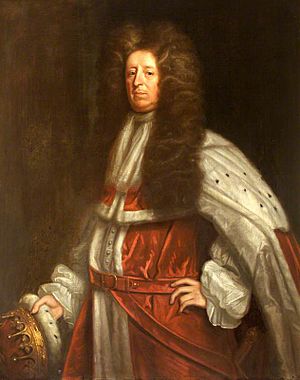Richard Lumley, 1st Earl of Scarbrough facts for kids
Quick facts for kids
The Earl of Scarbrough
|
|
|---|---|

Portrait by Peter Lely
|
|
| Chancellor of the Duchy of Lancaster | |
| In office 12 March 1716 – 19 June 1717 |
|
| Monarch | George I |
| Preceded by | The Earl of Aylesford |
| Succeeded by | Nicholas Lechmere |
| Personal details | |
| Born | 1650 |
| Died | 17 December 1721 |
| Spouse | Frances Jones |
| Children | 9, including Henry, Richard, Thomas, Charles, John, and James |
Richard Lumley, the 1st Earl of Scarbrough, was an important English soldier and politician. He was born around 1650 and passed away on December 17, 1721. He is most famous for his part in the Glorious Revolution, a big event in English history. He was also a member of the Whig political party.
Contents
Early Life and Family History
Richard Lumley came from a very old family in northern England. His grandfather was the 1st Viscount Lumley. Richard became the 2nd Viscount Lumley when his grandfather died in 1661 or 1662. This happened because Richard's father had passed away earlier. Richard grew up as a Roman Catholic. He later became a Protestant before joining the House of Lords in 1685.
Starting His Career
Richard Lumley began his career by helping important people. In 1679, he traveled with the Duke of York to Scotland. The next year, he volunteered for a military trip to Tangier. In 1680, he became the Master of the Horse for Catherine of Braganza, who was the Queen. He later became her Treasurer in 1684.
King Charles II made him Baron Lumley in 1681. Richard Lumley played a key role in stopping the rebellion led by the Duke of Monmouth. He was personally responsible for catching Monmouth in 1685. From 1685 to 1687, he was a Colonel in the Queen Dowager's Regiment of Horse.
Role in the Glorious Revolution
Richard Lumley was one of the "Immortal Seven". These were English noblemen who invited William of Orange to invade England. Their goal was to remove King James II from the throne. In December 1688, Lumley helped secure Newcastle for William.
After William became King, Lumley quickly received many important jobs. In 1689 and 1690, he became a Gentleman of the Bedchamber. He also joined the Privy Council. He was made Colonel of the 1st Troop of Horse Guards. He also became Viscount Lumley of Lumley Castle. On top of that, he was appointed Lord Lieutenant of Northumberland and Lord Lieutenant of Durham. On April 15, 1690, he was given the title Earl of Scarbrough.
Later Military and Political Roles
As Earl of Scarbrough, he fought in the Battle of the Boyne in 1690. This was a very important battle. Afterward, he served in Flanders. He became a major-general in 1692 and a lieutenant-general in 1694. He stopped active military service after the Treaty of Ryswick in 1697. However, he received a new commission as a lieutenant-general in 1702.
From 1716 to 1717, he served as the Chancellor of the Duchy of Lancaster. After he became an Earl, he made his family home, Lumley Castle, much larger. He passed away on December 17, 1721, in Soho, London.
Family Life
Richard Lumley was married to Frances Jones (1665–1722). She was the daughter of Sir Henry Jones of Oxfordshire. Countess Frances also held an important position. She served as a Lady of the Bedchamber for Queen Anne.
Richard and Frances had nine children together:
- Henry Lumley, Viscount Lumley (died 1710)
- Richard Lumley, 2nd Earl of Scarbrough (1688 – 1739)
- Mary Lumley (1690 – 1726), who married George Montague, 1st Earl of Halifax
- William Lumley (died 1709)
- Thomas Lumley, 3rd Earl of Scarborough (1691 – 1752)
- Charles Lumley (around 1693–1728)
- Ann Lumley (died 1740)
- John Lumley (around 1703–1739)
- James Lumley (around 1706–1766)
Images for kids
See also


